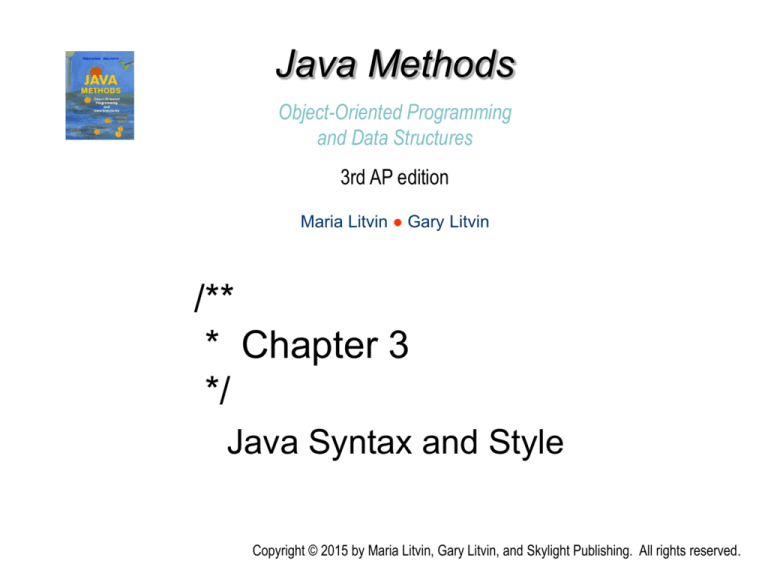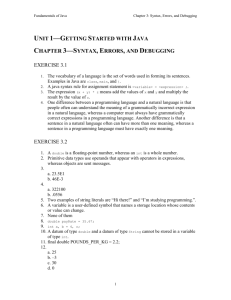
Java Methods
Object-Oriented Programming
and Data Structures
3rd AP edition
Maria Litvin ● Gary Litvin
/**
* Chapter 3
*/
Java Syntax and Style
Copyright © 2015 by Maria Litvin, Gary Litvin, and Skylight Publishing. All rights reserved.
Objectives:
• Learn to distinguish the required Java syntax
from the conventional style
• Learn when to use comments and how to
mark them
• Review reserved words and standard names
• Learn the proper style for naming classes,
methods, and variables
• Learn to space and indent blocks of code
3-2
Comments
• Comments are notes in plain English inserted
in the source code.
• Comments are used to:
document the program’s purpose, author, revision
history, copyright notices, etc.
describe fields, constructors, and methods
explain obscure or unusual places in the code
temporarily “comment out” fragments of code
3-3
Formats for Comments
• A “block” comment is placed between /* and
*/ marks:
/* Exercise 3-2 for Java Methods
Author: Miss Brace
Date: 3/5/2020
Rev. 1.0
*/
• A single-line comment goes from // to the end
of the line:
weight *= 2.2046;
// Convert to kilograms
3-4
Javadoc Comments
• Used by the JDK’s special utility program
javadoc to automatically generate
documentation in HTML format from the
source code
• Should precede a class, a method, or a field
• Can use special javadoc tags:
@param – describes a parameter of a method
@return - describes the method’s return value
3-5
Javadoc Comments (cont’d)
/** indicates a javadoc
comment
/**
*
*
*
*
*
*/
Returns total sales from all vendors;
sets <code>totalSales</code>
to 0.
Can use
HTML tags
@return total amount of sales from all vendors
Common
style
3-6
Reserved Words
• In Java a number of words are reserved for a
special purpose.
• Reserved words use only lowercase letters.
• Reserved words include:
primitive data types: int, double, char, boolean,
etc.
storage modifiers: public, private, static, final, etc.
control statements: if, else, switch, while, for, etc.
built-in constants: true, false, null
• There are about 50 reserved words total.
3-7
Programmer-Defined Names
• In addition to reserved words, Java uses
standard names for library packages and
classes:
String, Graphics, JFrame, JButton,
java.awt, javax.swing
• The programmer gives names to his or her
classes, methods, fields, and variables.
3-8
Names (cont’d)
• Syntax: A name can include:
upper- and lowercase letters
digits
underscore characters
• Syntax: A name cannot begin with a digit.
• Style: Names should be descriptive to
improve readability.
3-9
Names (cont’d)
• Programmers follow strict style conventions.
• Style: names of classes begin with an
uppercase letter, subsequent words are
capitalized:
public class RoundBalloon
• Style: names of methods, fields, and
variables begin with a lowercase letter,
subsequent words are capitalized:
private int xCenter;
public bolean isInside()
3-10
Names (cont’d)
• Method names often sound like verbs:
setBackground, getText, moveForward, stop
• Field names often sound like nouns:
color, radius, button, controlPanel
• Constants often use all caps:
PI, PIXELS_PER_INCH
• It is OK to use short names for temporary
“throwaway” variables:
i, k, x, y, str
3-11
Syntax vs. Style
• Syntax is part of the language. The compiler
checks it.
• Style is a convention widely adopted by
software professionals.
• The main purpose of style is to improve the
readability of programs.
3-12
Syntax
• The compiler catches syntax errors and
generates error messages.
• Text in comments and literal strings within
double quotes are excluded from syntax
checking.
• Before compiling, carefully read your code a
couple of times to check for syntax and logic
errors.
3-13
Syntax (cont’d)
• Pay attention to and check for:
matching braces { }, parentheses ( ), and
brackets [ ]
missing or extraneous semicolons
correct symbols for operators
+, -, =, <, <=, ==, ++, &&, etc.
correct spelling of reserved words, library names
and programmer-defined names, including
upper/lower case
3-14
Syntax (cont’d)
• Common syntax errors:
Spelling
(p P,
if If)
Missing
closing
brace
Public static int abs (int x)
{
If (x < 0);
{
Extraneous
x = -x
semicolon
}
return x;
Missing
semicolon
public static int sqrt (int x)
...
3-15
Style
• Arrange statements on separate lines
• Insert blank lines between fragments of
code.
• Indent code within braces.
• Use comments judiciously: comment
constructors, methods, fields, important
steps, but not every statement in the
program.
3-16
Style (cont’d)
public void draw
(Graphics g, boolean
makeItFilled)
{g.setColor(color);if
(makeItFilled)
g.fillOval(xCenterradius,yCenter-radius,
2*radius,2*radius);
else g.drawOval
(xCenter-radius,
yCenter-radius,
2*radius,2*radius);}
Compiles fine
public void draw(Graphics g,
boolean makeItFilled)
{
g.setColor(color);
if (makeItFilled)
g.fillOval(xCenter - radius,
yCenter - radius,
2*radius, 2*radius);
else
g.drawOval(xCenter - radius,
yCenter - radius,
2*radius, 2*radius);
}
A little more readable
3-17
Style (cont’d)
public void fill (char ch)
{
int rows = grid.length, cols = grid[0].length;
for (int r = 0; r < rows; r++)
{
for (int c = 0; c < cols; c++)
{
grid[r][c] = ch;
}
}
}
Add blank lines for
readability
Add spaces around operators and
after semicolons
3-18
Blocks, Indentation
• Java code consists mainly of declarations
and control statements.
• Declarations describe objects and methods.
• Control statement describe actions.
• Declarations and control statements end with
a semicolon.
• No semicolon is used after a closing brace
(except in certain array declarations).
3-19
Blocks, Indentation (cont’d)
• Braces mark nested blocks.
• Braces indicate that the statements within
them form one compound statement.
• Statements inside a block are indented,
usually by two spaces or one tab.
3-20
private static void merge(double[] a,
int from, int middle, int to)
{
int i = from, j = middle + 1, k = from;
while (i <= middle && j <= to)
{
if (a[i] < a[j])
{
One
temp[k] = a[i];
compound
i++;
statement
}
else
{
One
temp[k] = a[j];
compound
j++;
statement
}
Method’s
body
One
compound
statement
k++;
}
...
}
3-21
Review:
• Name as many uses of comments as you
can.
• What does the javadoc program do?
• Explain the difference between syntax and
style.
• Why is style important?
• Roughly how many reserved words does
Java have?
3-22
Review (cont’d):
• Explain the convention for naming classes,
methods, and variables.
• Which of the following are syntactically valid
names for variables: C, _denom_, my.num,
AvgScore, count1, 7seas? Which of them
are in good style?
• What can happen if you put an extra
semicolon in your program?
3-23
Review (cont’d):
• What are braces used for in Java?
• Is indentation required by Java syntax or
style?
3-24








